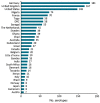Around the World in 1,475 Salmonella Geo-serotypes
- PMID: 39772279
- PMCID: PMC4918176
- DOI: 10.3201/eid2207.141678
Around the World in 1,475 Salmonella Geo-serotypes
Abstract
It's easy to remember Salmonella serotypes names, isn't it? Surely, this is because the naming system of Salmonella serotypes is by far the most scientist friendly. Traditionally, most Salmonella serotypes have been named after geographic locations. We decided to explore the geographic locations to which Salmonella serotypes refer and describe some unexpected twists in the naming scheme. We found that 93% (n = 1,475) of the 1,585 serotypes could be categorized as geo-serotypes; that is, the name refers to a geographic location. The 3 countries with the most geo-serotypes are Germany, the United Kingdom, and the United States. Other serotype names refer to the name of a person, animal, tribe, or food item or are a composite of symptoms and host. The Salmonella serotypes naming scheme has had a valuable effect on public health microbiology, and in the current era of fast development of whole-genome sequencing, it should remain a reference.
Keywords: Salmonella serotypes; White-Kauffmann-Le Minor scheme; bacteria; enteric infections; geo-serotype; geographic locations; naming; salmonellae; serovars.
Figures


References
-
- Mastroeni P, Maskell D, editors. Salmonella infections: clinical, immunological and molecular aspects. Cambridge (UK): Cambridge University Press; 2006.
-
- Grimont PAD, Weill FX. Antigenic formulae of the Salmonella serovars, 9th ed. Paris: World Health Organization Collaborating Center for Reference and Research on Salmonella, Institut Pasteur; 2007.
-
- Institut Pasteur. Salmonella. Centre Collaborateur de l’OMS (CCOMS) de Référence et de Recherche pour les Salmonella [cited 2016 Feb 17]. http://www.pasteur.fr/fr/sante/centres-collaborateurs-l-oms-ccoms/salmon...
-
- De Vos P, Truper HG, Tindall BJ. Judicial Commission of the International Committee on Systematics of Prokaryotes Xth International (IUMS) Congress of Bacteriology and Applied Microbiology. Minutes of the meetings, 28, 29 and 31 July and 1 August 2002, Paris, France. Int J Syst Evol Microbiol. 2005;55:525–32. 10.1099/ijs.0.63585-0 - DOI
LinkOut - more resources
Full Text Sources
